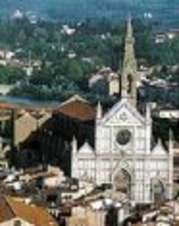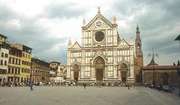Firenze - Santa Croce
Basilica di Santa Croce

This gothic church contains tombs of many famous artists amongst which Michelangelo, Ghiberti, Machiavelli, Dante and Galileo are included. Santa Croce, after which the church was named, played a signif?cant role in the evolution of the Renaissance thought. The full sessions of the Council of Florence which attempted to reconcile the differences between the Roman and Eastern churches took place in this church. Santa Croce has traditionally always been used for important civic and religious events because it is large enough to contain crowds of people.
This is where the Franciscan preachers, as well as St. Bernardino of Siena, during the plague of 1437, addressed the population. This was also where Carnival and May Day festivities were celebrated, as well as tournaments, jousting and carousels, especially during the Renaissance, with the participation of the younger members of the Florentine aristocracy. Such events included the famous jousts described by Pulci (1469) and Poliziana (1475), with Lorenzo and Giuliano de' Medici among the principal protagonists.
The interior is spacious and is enhanced by the radiant frescoes of Giotto and his gifted pupil, Taddeo Gaddi which were painted early 14th century. In the nave, almost every object of interest if the funerary monument. Brunellischi's classical Cappella de' Pazzi is the masterpiece of the Reinaissance architecture. The two chapels on the right (Cappella Peruzzi and the Cappella Bardi) of the chapel are covered in frescoes by Giotto who later assisted by other artists. The Peruzzi chapel is covered by scenes from the lives of St. John the Evangelist and St John the Baptist. The Bardi, on the other hand, is covers by the life of St. Francis.The Funeral of Saint Francis, though sad, still communicates the same feeling of the grief-stricken mourners despite of its areas of paint destroyed by the removal of the tomb to attach it to the wall.
The cloister of variours artistic works has been gathered in the Museo dell'Opera di Santa Croce to build the atmosphere of the Church of Santa Croce. The Museum of the Opera di San Croce has some of the most important Florentine masterpieces with works by: Cimabue, Orcagna, Donatello, Domenico Veneziano. Unfortunately many works such as the Crucifix by Cimabue were damaged in the flood of November 1966.
On the far end of the Cloister a magnificent portal of the XV century by Giuliano da Maiano with a front portico that leads to the Pazzi Chapel, last creation of Brunelleschi,who began it in 1443 for Andrea de' Pazzi but died before finishing the facade which, after his death,was continued by his collaborators who left the pronaos incomplete.On the portico, the cupola in the form of an umbrella with ceramic medallions decorated by Luca della Robbia
Cripta Caduti nella Basilica di Santa Croce

The Franciscan church was consecrated in 1443 and features a Gothic interior in the shape of a cross, with a nave and two side aisles, supported by large octagonal pillars. The church contains frescoes by Giotto in the Peruzzi and Bardi chapels, as well as L. Bruni's tomb (by Rossellino) and Benedetto da Maiano's octagonal marble pulpit. Two sculptures by Donatello, the Annunciation and the Woodden Crucifix, can also be admired inside the church. Attached to the church, one can see the Pazzi chapel, started by Brunelleschi in 1443 for Andrea de’ Pazzi but never completed.